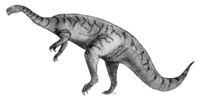Plateosaurus
2007 Schools Wikipedia Selection. Related subjects: Dinosaurs
| iPlateosaurus |
||||||||||||||||||||
|---|---|---|---|---|---|---|---|---|---|---|---|---|---|---|---|---|---|---|---|---|
 A Plateosaurus sketch by Tim Bekaert.
|
||||||||||||||||||||
|
|
||||||||||||||||||||
|
Extinct (fossil)
|
||||||||||||||||||||
| Scientific classification | ||||||||||||||||||||
|
||||||||||||||||||||
|
|
||||||||||||||||||||
| Plateosaurus engelhardti von Meyer, 1837 |
Plateosaurus (meaning 'flat lizard' - Greek πλατυς/platys "broad" or "flat" from πλατη/platé meaning "flat surface" and σαυρος meaning "lizard") was the largest dinosaur known to have existed during the Triassic Period of the Mesozoic Era, reaching 6 to 10 m in length and up to an estimated 700 kg in mass. Like all sauropodomorphs, Plateosaurus was a saurischian.
Discovery and species
Plateosaurus is one of the most common dinosaur fossils found in Europe and has been found in over 50 locations on that continent.
The first species, P. engelhardti, was described by the German palaeontologist Hermann von Meyer, from some vertebrae and leg bones discovered at Heroldsberg near Nuremberg, in Germany, in 1837. P. longiceps was described by Jaekel in 1914, and is the species to which the vast majority of fossil material belongs. P. engehardti is known only from Bavaria, Germany, while P. longiceps is known from other areas of southern Germany, France, Switzerland, and Greenland.
P. longiceps had a longer snout and less massive hindlimbs than P. engelhardti .
Plateosaurus species
- P. engelhardti ( type)
- P. longiceps
A third species, P. gracilis lacks certain features of the genus Plateosaurus and has been placed in its own genus Sellosaurus.
Paleobiology
A member of the group of early herbivores, known as prosauropods, it had a long neck, stocky body and a pear-shaped trunk. A recent analysis of fossil deposits reveals there was considerable variation in size in individuals. Furthermore, growth rings in bone suggests periods of varying growth which may relate to the surrounding environment. The paper's author Klein proposes that the metabolism of Plateosaurus may have been intermediate between a reptilian and warm-blooded one.
The skull of Plateosaurus was deeper than that of Coelophysis, although still small and narrow compared to the size of its body. It had a long snout and socketed teeth and its eyes were directed to the sides, rather than the front, providing all-round vision to watch for predators.
Like all prosauropods, Plateosaurus had forelimbs which were much shorter than the hind limbs and they had distinct digits ('fingers') and a spiked 'thumb'. This suggests that, while its mass suggests it was mainly quadrupedal, it may have been able to rear up on its hind legs. The forelimbs may have been used to rake trees for food, for grasping or for defence.
The natural environment of Plateosaurus was desert-like land in Europe.
Popular culture
Plateosaurus featured briefly in Walking With Dinosaurs, to illustrate the success of dinosaurs.
Mounted Plateosaurus skeletons can be seen in the Institute and Museum for Geology and Paleontology, University of Tübingen, and the Humboldt Museum in Berlin, and the State Museum for Natural History in Stuttgart.
